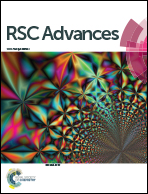Design and development of a topical dosage form for the convenient delivery of electrospun drug loaded nanofibers
Abstract
In the recent years, nanofiber based delivery systems have gained a lot of importance in the biomedical field. However, convenient administration of nanofibers and development of a dosage form for nanofibers is a great challenge to the formulation scientist. Topical application of nanofibers has its own disadvantages such as vehicle deployment, spreading and retention in the specific site of action. Thus, in this study, we have attempted to develop a topical gel for the effective application and administration of fluconazole loaded eudragit nanofibers. The electrospun nanofiber loaded topical gel was evaluated for the drug content, rheological behavior, permeation efficiency and antifungal activity. Controlled release of the drug up to 24 h was observed in the in vitro diffusion studies and a better drug release was obtained in the nanofiber loaded gel based delivery system when compared to the release profile of nanofibers alone. Antifungal study confirmed the efficiency of the developed system in controlling fungal growth. Thus, an efficient dosage form for the delivery of drug loaded nanofibers has been developed and it opens up new avenues for the treatment of topical infections using nanofiber based therapeutics.


 Please wait while we load your content...
Please wait while we load your content...